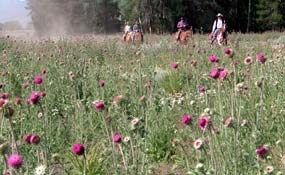Events often take place that alter the balance of an ecosystem and affect the species within. Areas can become altered, or "disturbed," through a natural or human-caused occurrence.
Natural disturbances range from earthquakes to fires to floods to volcanic eruptions. Human-caused disturbances include road construction, agriculture, and urban/suburban development. Disturbed lands may be barren, void of plant and animal life, following an incident. Some native species of plants thrive after a disruption of the natural balance. The first returnees to a burned area, for instance, are grasses that take advantage of increased sunlight, decreased shade, increased nutrients in the soil, and lower acidity levels in the soil.
After a disturbance, the topsoil is susceptible to erosion due to landslides after rainfall. Often a disturbed area is threatened by the generation of invasive, non-native or exotic plant and animal species. This is evident along roadsides in Grand Teton National Park that contain fields of Canada thistle, houndstongue, yellow toadflax (butter and eggs), and mullein. These new species do not have natural environmental controls (e.g. predators) and can easily out-compete native species. Eventually disturbed lands may become dominated by non-native species.

